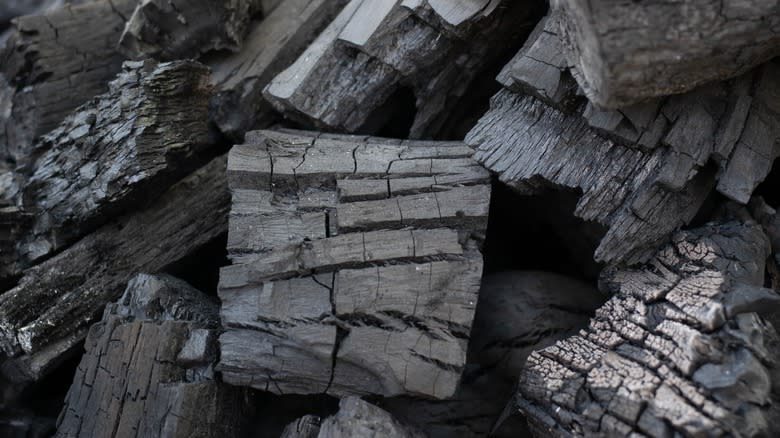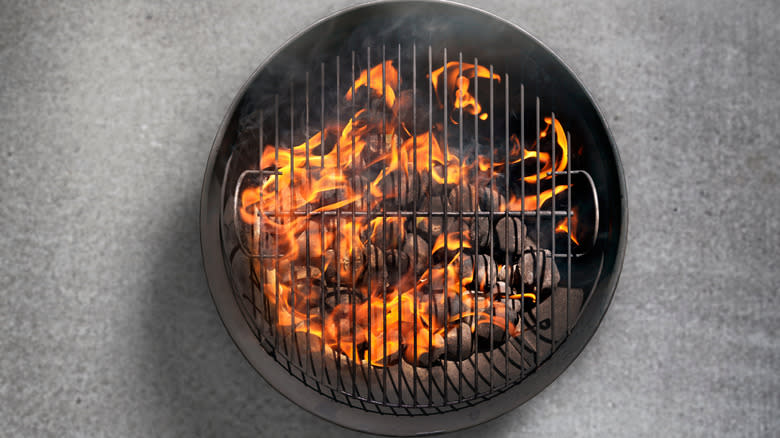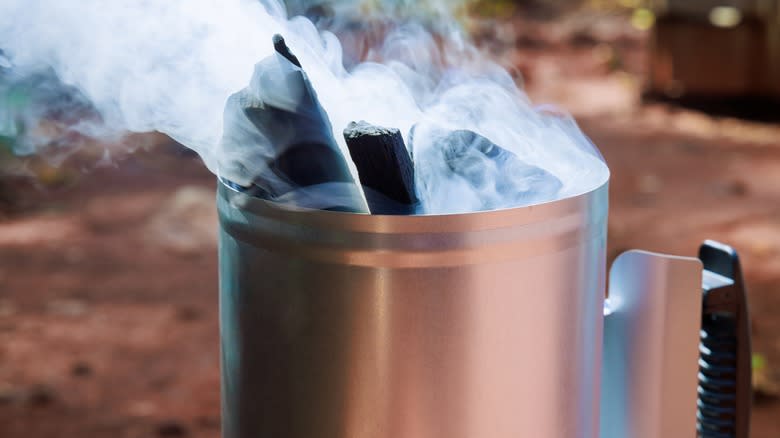How To Reuse Charcoal For Your Grill And Save Some Money

It's ideal -- in theory -- to cook with the finest ingredients using the best tools available, but it's not always easy in practice (and we all know the only difference between theory and practice is, well, practice.) Sure, you can get quick-lighting charcoal briquettes on the cheap, but who wants their burgers to taste like lighter fluid? Still, there's no getting around the fact that high-quality hardwood charcoal (either lump or briquettes) can be pretty pricey. Well, there's a way to have your cake and grill it, too (you know what we mean), by using premium charcoal and then reusing it. The condition of your brisket, as well as your bank account, will remain undiminished.
There are a couple of tricks to reusing charcoal -- mostly having to do with preserving its quality and lighting it effectively -- but these are small concessions to seeing hard-earned money going up in smoke. After all, of all the cooking methods (induction, electric elements, gas, et cetera), grilling is the least efficient while also the most flavorful. The trick to reusing charcoal effectively has much to do with when you're done grilling the first time.
Read more: 11 Tips For Keeping Your Grill Shiny And Clean
Reusing Charcoal, Step One: Selection And Preservation

First, use the best charcoal you can get your hands on. Forget so-called self-igniting charcoal briquettes because they contain an accelerant in the form of lighter fluid, which is made from straight-up toxins like petroleum distillates and naphthalene. Instead, buy either hardwood lump (the pricier option with cleaner smoke) or hardwood briquettes (easier to light, more uniform heat). Lump charcoal is one step removed from actual wood, while briquettes are often made with a binder like starch or sand. You'll need a chimney starter (which also happens to be the secret to perfectly charred veggies) to light either one of these charcoal types -- and, while that might take a few minutes longer than using self-lighting briquettes or hosing the whole thing down with lighter fluid, we are in the pursuit of quality, after all. Be sure to burn these guys hot to remove any moisture or impurities -- not a big ask since most grilled foods need to be cooked over high heat. (Use this helpful trick if your charcoal grill won't stay lit.)
Once you're done grilling the first time, shut down the air vents on your grill to extinguish the fire. Do not dump water on them, as this could cause damage to your grill through thermal shock. An hour or two after you eat, transfer the cooled charcoal into a non-combustible metal container with a lid. The purpose of this is to keep out moisture and other environmental contaminants.
Reusing Charcoal, Step Two: The Sorting Process

When you're ready to grill again, place your chimney starter on top of your grill grate and fill it with the used charcoal. The smaller pieces will fall through the bottom of the starter and back into the grill -- and this is great because too-small pieces of charcoal will bunch up and restrict needed airflow. Dump the remaining used charcoal back into its metal container and fill the chimney starter halfway with fresh coals, topping them with some of your used supply (any remaining used charcoal can go into the grill).
Now you've established a process that can carry on: The used charcoal from this grilling session (already likely supplemented by fresh, unburned pieces) can be extinguished, allowed to cool, and returned to your lidded can of used charcoal, where it can once again be called upon to put a proper sear on the best grilled steak. It's sort of like the Medieval idea of "perpetual stew," in which ingredients are added to the cooking pot indefinitely because it's always on heat. OK -- it's sort of like that in theory but not nearly as gross in practice.
Read the original article on Daily Meal

